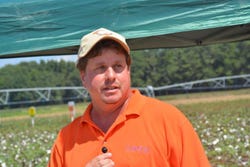
Scientists at Clemson University’s Pee Dee Research and Education Center in Florence, S.C. are turning to technology to improve their cotton breeding program with high throughput phenotyping showing great promise in identifying cotton varieties that shine.
Speaking at the Pee Dee Farm Field Day at the Pee Dee Center Sept. 10, Todd Campbell, USDA-ARS research geneticist at the center, said high throughput phenotyping is a field-based platform that allows researchers to rapidly make decisions in the cotton breeding program and separate top varieties from poor performers.
He said the technology is vital in improving cotton genetics and germplasm.
“We use high throughput phenotyping to improve the efficiency and effectiveness of our breeding program," Campbell said. "We can use it as a tool to discard poor performers early in our breeding program. We can really have the chance to increase the efficiency of our breeding program because by discarding those poor performers early in the breeding process, we can then focus our attention on extensive field evaluations that are required for more promising material.”
In the field, Clemson scientists are using a high clearance tractor equipped with Normalized Difference Vegetation Index (NDVI) sensors and thermometers to measure canopy temperatures. The specially-equipped tractor also includes a global positioning system unit that gathers and calculates a vast amount of data from the field.
“We are using NDVI and canopy temperature to assess genetic diversity under stress conditions such as drought. We’re also interested in using NDVI to possibly estimate yield potential,” Campbell explained
In addition, Clemson is using an unmanned aerial vehicle to collect images and then use image analysis techniques to see if they can predict yield potential on a per plot basis, Campbell said.

Clemson University Cotton Specialist Mike Jones says variety selection is one of the most critical decisions a cotton farmer makes.
In the meantime, Mike Jones, Clemson’s cotton specialist, emphasized that variety selection is one of the most critical decisions a cotton farmer makes. “There’s probably no one decision that you make that can cost you more in the field than picking the wrong variety. It’s really important that you do your homework on these new varieties,” Jones said at the field day.
At the Pee Dee Center, Jones has a 35 acre small plot trial where he does much of his variety research. The plot has 54 different varieties grown in the same field, managed the same way and treated the same with the same rain patterns, Jones explained.
These days, variety turnover is very rapid, Jones explained. He said this is a good thing because the newer varieties generally offer improved yield, fiber quality and other positive characteristics.
“It is rare that we as scientists get to evaluate these varieties for more than two years. These varieties are in our OVT (Official Variety Trial) for one or two years and they are replaced. That’s a good thing because we are replacing them with better higher yielding cotton varieties with new transgenic technology.”
Jones said the rapid changes in technology will continue. “We will have new dicamba-resistant cotton varieties and 2, 4-D resistant cotton varieties coming onto the market that will probably replace what we are growing now. It is very critical for us to evaluate these new varieties.”
About the Author(s)
You May Also Like






